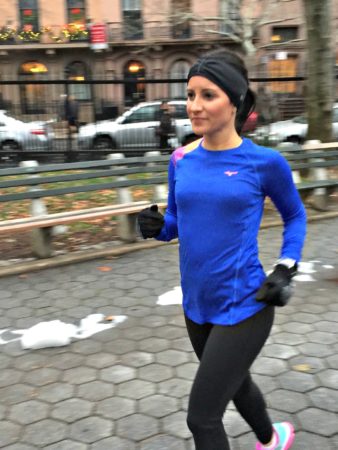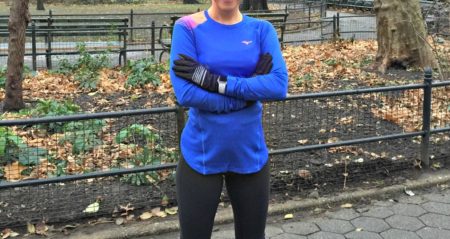This post is sponsored by FitFluential LLC on behalf of Mizuno. All opinions are my own.
I clearly remember the first Winter I braved the elements in New York City and ran outdoors. It was 2005 and I was training with the Leukemia and Lymphoma Society’s (LLS) Team in Training for an April Olympic-distance Triathlon in Florida. At the information session, when I learned that the program would require me to train outside in Central Park from November until the April race day, I almost re-thought my decision. I could have used a few Winter running tips right then and there, but instead I had to learn on my own from coaches and team mates. I had only been running a few years and before then, I dutifully moved my running indoors when the elements set in. Now, I love Winter running so I’m happy to bring you these Winter running tips in partnership with Mizuno to keep you toasty all Winter long.
Base Layer // Gloves
Get the Right Gear: I’m not kidding when I say that signing up for that triathlon with Team in Traning had me asking all kinds of questions like, “what do you do about running and cycling outside in the cold?” Thinking the answer would be that workouts happened indoors, to this day I remember the LLS employee kindly telling me that you dress in layers and get it done. Outside. In the cold. I had to figure out what exactly that meant but I soon discovered that a hat, gloves and light, warm, absorbent layers are a necessity.
I recently had the chance to try out the Mizuno Breath Thermo Warmalite Gloves and the Mizuno Women’s Breath Thermo Base Layer. Mizuno’s cold weather apparel is engingeered to keep you warm without weighing you down. The gloves are made with Breath Thermo fleece which generates heat for additional warmth, they have a touch screen forefinger which is always helpful for using your phone or watch with a gloved hand, reflective strips for night or early-morning running and a storage pocket for stashing a house key or cash. The base layer is a flattering fit. For really cold days I would add another layer on top, but the coverage makes it perfect for wearing with leggings or running tights on its own if you live in a warmer climate or if your Winter weather is more mild. Like the gloves, it’s made of a heat-generating material and also has reflective stripes.
Hydrate: This may seem like a given in heat and humidity, but it’s also important in the cold. Regardless of the outdoor temperature, you must stay hydrated for outdoor activities. Make sure you’re properly hydrated before you go out on your run and avoid drinking ice cold water or sports drink during exercise. After your run, hydrate again and avoid anything ice cold. To warm-up, you may wish to sip on a warm drink like hot water with lemon or a warm mug of chocolate milk or hot cocoa, which helps with replenishing glycogen stores (see below tip) – just watch the added sugar and opt for something homemade whenever possible.
Fuel Your Run: Did you know that food is also an important winter running essential? The energy you get from food will fuel your body and give you the energy you need for a run of any length, but also keep you warm. At least two hours before running, make sure to fuel up with carbohydrates or healthy fats to elevate your body temperature. Bonus points for warm foods like a bowl of oatmeal or quinoa porridge.
Replenish Glycogen Stores: Re-store glycogen 30-minutes to an hour post-exercise with warm, slow-burning carbohydrates and protein. Stick with warm foods like soup or chili, bone broth or even a warm smoothie (yes it’s a thing … Google it!).
Warm-up Inside: Heading out for a run with cold joints and muscles puts you at risk for injury so make sure you spend five to 10 minutes doing dynamic or functional movements like leg raises or crawl-outs to warm your muscles before heading out the door.
How do you prepare for Winter runs? Share your best winter running tips with me in the comments.






Leave a Reply